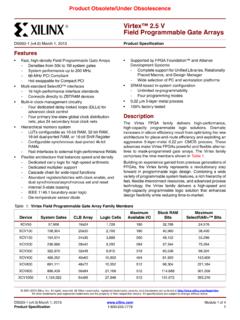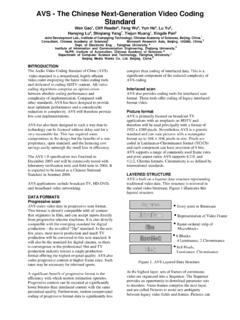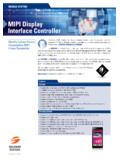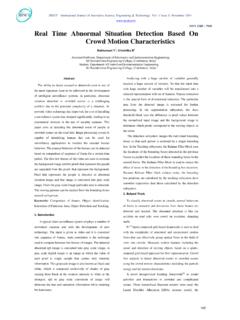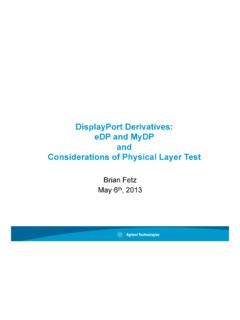Transcription of Accelerating OpenCV Applications with Zynq-7000 All ...
1 Application Note: Vivado HLS. Accelerating OpenCV Applications with Zynq-7000 All Programmable SoC using XAPP1167 ( ) June 24, 2015 Vivado HLS video Libraries Author: Stephen Neuendorffer, Thomas Li, and Devin Wang Summary This application note describes how the OpenCV library can be used to develop computer vision Applications on zynq -7000 All Programmable SoCs. OpenCV can be used at many different points in the design process, from algorithm prototyping to in-system execution. OpenCV code can also migrate to synthesizable C++ code using video libraries that are delivered with Vivado High-Level Synthesis (HLS). When integrated into a zynq SoC design, the synthesized blocks enable high resolution and frame rate computer vision algorithms to be implemented. Introduction Computer vision is a field that broadly includes many interesting Applications , from industrial monitoring systems that detect improperly manufactured items to automotive systems that can drive cars.
2 Many of these computer vision systems are implemented or prototyped using OpenCV , a library which contains optimized implementations of many common computer vision functions targeting desktop processors and GPUs. Although many functions in the OpenCV . library have been heavily optimized to enable many computer vision Applications to run close to real-time, an optimized embedded implementation is often preferable. This application note presents a design flow enabling OpenCV programs to be retargeted to zynq devices. The design flow leverages HLS technology in the Vivado Design Suite, along with optimized synthesizable video libraries. The libraries can be used directly, or combined with application-specific code to build a customized accelerator for a particular application. This flow can enable many computer vision algorithms to be quickly implemented with both high performance and low power.
3 The flow also enables a designer to target high data rate pixel processing tasks to the programmable logic, while lower data rate frame -based processing tasks remain on the ARM cores. As shown in the Figure below, OpenCV can be used at multiple points during the design of a video processing system. On the left, an algorithm may be designed and implemented completely using OpenCV function calls, both to input and output images using file access functions and to process the images. Next, the algorithm may be implemented in an embedded system (such as the zynq Base TRD), accessing input and output images using platform-specific function calls. In this case, the video processing is still implemented using OpenCV functions calls executing on a processor (such as the Cortex -A9 processor cores in zynq Processor System). Alternatively, the OpenCV function calls can be replaced by corresponding synthesizable functions from the xilinx Vivado HLS video library.
4 OpenCV . function calls can then be used to access input and output images and to provide a golden reference implementation of a video processing algorithm. After synthesis, the processing block can be integrated into the zynq Programmable Logic. Depending on the design implemented in the Programmable Logic, an integrated block may be able to process a video stream created by a processor, such as data read from a file, or a live real-time video stream from an external input. Copyright 2013 2015 xilinx , Inc. xilinx , the xilinx logo, Artix, ISE, Kintex, Spartan, Virtex, zynq , and other designated brands included herein are trademarks of xilinx in the United States and other countries. All other trademarks are the property of their respective owners. XAPP1167 ( ) June 24, 2015 1. Reference Design X-Ref Target - Figure 1. ,PDJH 5 HDG 2 SHQ&9 ,PDJH 5 HDG . 9 LGHR )UDPH 5 HDG 9 LGHR )UDPH 5 HDG.
5 2 SHQ&9 2 SHQ ,YLGHR. $;,YLGHR 0DW. 2 SHQ&9 IXQFWLRQ 2 SHQ&9 IXQFWLRQ +/6 YLGHR OLEUDU\ 6\QWKHVL]HG )3*$. 6\QWKHVL]DEOH. FKDLQ FKDLQ IXQFWLRQ FKDLQ 3 URFHVVLQJ %ORFN. %ORFN. 0DW $;,YLGHR. $;,YLGHR 2 SHQ&9. ,PDJH :ULWH . 9 LGHR )UDPH :ULWH 9 LGHR )UDPH :ULWH. 2 SHQ&9 ,PDJH :ULWH 2 SHQ&9 Figure 1: Design Flow The design flow for this application note generally follows the steps below: 1. Develop and execute an OpenCV application on Desktop. 2. Recompile and execute the OpenCV application in the zynq SoC without modification. 3. Refactor OpenCV application using I/O functions to encapsulate an accelerator function. 4. Replace OpenCV function calls with synthesizable video library function calls in accelerator function. 5. Generate an accelerator and corresponding API from the accelerator function using Vivado HLS. 6. Replace calls to the accelerator function with calls to the accelerator API.
6 7. Recompile and execute the accelerated application Reference The reference design files can be downloaded from: Design The reference design matrix is shown in Table 1. Table 1: Reference Design Matrix Parameter Description General Developer name Thomas Li Target devices (stepping level, ES, production, XC7020-1. speed grades). Source code provided Yes Source code format C. Design uses code/IP from existing xilinx Yes, based off the zynq Base TRD application application note/reference designs, CORE note/reference designs, CORE Generator Generator software, or third party software, or third party Simulation XAPP1167 ( ) June 24, 2015 2. video Processing Libraries in Vivado HLS. Table 1: Reference Design Matrix Parameter Description Simulation Functional simulation performed Yes, in C. Timing simulation performed No Test bench used for functional and timing Provided simulation Test bench format C.
7 Simulation software/version used g++. SPICE/IBIS simulations No implementation Implementation Synthesis software tools/version used Vivado Implementation software tools/versions used Vivado Static timing analysis performed Yes Hardware Verification Hardware verified Yes Hardware platform used for verification ZC702. video Vivado HLS contains a number of video libraries, intended to make it easier for you to build a Processing variety of video processing. These libraries are implemented as synthesizable C++ code and roughly correspond to video processing functions and data structures implemented in OpenCV . Libraries in Many of the video concepts and abstractions are very similar to concepts and abstractions in Vivado HLS OpenCV . In particular, many of the functions in the OpenCV imgproc module have corresponding Vivado HLS library functions. For instance, one of the most central elements in OpenCV is the cv::Mat class, which is usually used to represent images in a video processing system.
8 A cv::Mat object is usually declared as shown in the following example: cv::Mat image(1080, 1920, CV_8UC3);. This declares a variable image and initializes it to represent an image with 1080 rows and 1920. columns, where each pixel is represented by 3 eight bit unsigned numbers. The synthesizable library contains a corresponding hls::Mat<> template class that represents a similar concept in a synthesizable way: hls::Mat<2047, 2047, HLS_8UC3> image(1080, 1920);. The resulting object is similar, except the maximum size and format of the image are described using template parameters in addition to constructor arguments. This ensures that Vivado HLS. can determine the size of memory to be used when processing this image and optimize the resulting circuit for a particular pixel representation. The hls::Mat<> template class also supports dropping the constructor arguments entirely when the actual size of the images being processed is the same as the maximum size: hls::Mat<1080, 1920, HLS_8UC3> image().
9 Similarly, the OpenCV library provides a mechanism to apply a linear scaling to the value of each pixel in an image in the cvScale function. This function might be invoked as shown below: cv::Mat src(1080, 1920, CV_8UC3);. cv::Mat dst(1080, 1920, CV_8UC3);. XAPP1167 ( ) June 24, 2015 3. Architectures for video Processing cvScale(src, dst, , );. This function call scales pixels in the input image src by a factor of 2 with no offset and generates an output image dst. The corresponding behavior in the synthesizable library is implemented by calling the hls::Scale template function: hls::Mat<1080, 1920, HLS_8UC3> src;. hls::Mat<1080, 1920, HLS_8UC3> dst;. hls::Scale(src, dst, , );. Note: Notice that although hls::Scale is a template function, the template arguments need not be specified, since they are inferred from the template arguments in the declaration of src and dst. The hls::Scale template function does require, however, that the input and output images have the same template arguments.
10 A complete list of the supported functions can be found in the Vivado Design Suite User Guide: High-Level Synthesis (UG902) [Ref 4]. Architectures video Processing Designs in zynq SoCs commonly follow one of the following two generic for video architectures. In the first architecture, referred to as direct streaming , pixel data arrives at the input pins of the Programmable Logic and is transmitted directly to a video processing Processing component and then directly to a video output. A direct streaming architecture is typically the simplest and most efficient way to process video , but it requires that the video processing component be able to process frame strictly in real time. X-Ref Target - Figure 2. ''5 . 3 URFHVVLQJ. 6\VWHP. ''5 0 HPRU\ &RQWUROOHU. $0%$ 6 ZLWFKHV. 6B$;,B+3 ELW. 6B$;,B*3 E ELW. $0%$ 6 ZLWFKHV. $;, 6 WUHDP. 86% &DPHUD +DUGHQHG $38 ,3 &RUH. 3 HULSKHUDOV 86% 'XDO &RUH.









